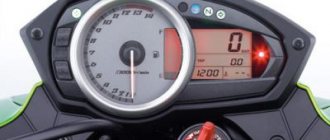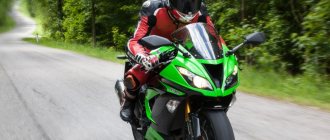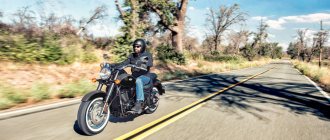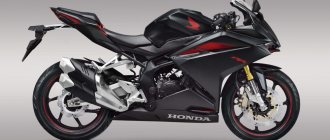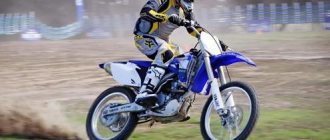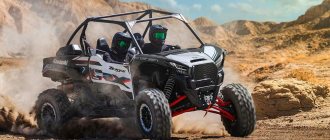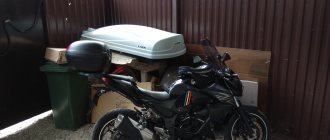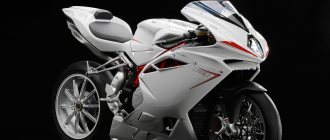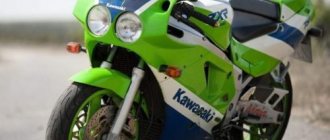RU-MOTO rating
- Reliability
- Chassis
- Appearance
- Comfort
- Ride quality
4.4
Verdict
The motorcycle is well suited for riding within the city. According to the owners' reviews, it is comfortable to drive the "ruff", the back does not get tired, the seat is not too soft and not hard. In my opinion, the design is a C plus.
Read other motorcycle reviews Review of Suzuki Boulevard M109R
Motorcycle Kawasaki ER-6N
The Kawasaki ER-6n abs motorcycle is designed and assembled in Japan. A street-class bike will be appreciated by professionals. It combines elegance and sportiness. The streamlined contours of the bike increase its aerodynamic characteristics, and the sharp edges and sections give it a unique and unique design.
The two-cylinder Kawasaki Ruff motorcycle with an engine capacity of 649 cm3 is equipped with a six-speed gearbox, and the transmission is ideally suited for city roads. A comfortable, low seat with fabric upholstery will bring real driving pleasure to its owner.
Specifications
The most important:
- power 72.1 hp;
- maximum speed 201 km/h;
- weight 206 kg;
- acceleration to 100 km/h in 3.7 s;
- fuel consumption from 3 to 4 liters.
| Engine | |
| Number of cycles | 4 |
| Number of cylinders | 2 |
| Number of valves per cylinder | 4 |
| Configuration | Row |
| Working volume | 649 cm³ |
| Bore and stroke | 83×60 mm |
| Maximum power | 72.1 hp at 8500 rpm |
| Maximum torque | 66 N•m at 7000 rpm |
| Intake type | Injector |
| Recommended fuel | AI-95 |
| Cooling system | Liquid |
| Starting system | Electric starter |
| Transmission | |
| Gearbox type | Mechanical |
| Number of gears | 6 |
| Clutch | Multi-disc, oil bath |
| main gear | Chain |
| Dimensions and weight | |
| Length | 2110 mm |
| Width | 770 mm |
| Height | 1180 mm |
| Seat height | 805 mm |
| Wheelbase | 1410 mm |
| Ground clearance | 130 mm |
| Curb weight | 204 kg |
| Fuel tank capacity | 16 l |
| Chassis and brakes | |
| Frame | Steel tubular |
| Suspension | |
| Front | Telescopic fork |
| Front suspension travel | 125 mm |
| Rear | Pendulum with monoshock absorber |
| Rear suspension travel | 130 mm |
| Brakes | |
| Ahead | Double disc hydraulic with 2 piston calipers |
| Diameter | 300 mm |
| Behind | Hydraulic disc with 1-piston caliper |
| Diameter | 220 mm |
| Tires | |
| Ahead | 120/70 ZR17 58W |
| Behind | 160/60 ZR17 69W |
| Production | |
| Country of Origin | Japan |
This post is a review post about my first motorcycle, on which I rode the 2015 season. In total, I rode 8 thousand kilometers on the motorcycle. I don’t know whether this is a lot or a little in 1 season, but before that I drove about 15 in a year by car. I rode both on long-distance trips and to work around the city. I rode lightly myself, and a lot with my girlfriend and a central trunk filled to capacity. We rode along a flat road at speeds of up to 200 km/h, in dead directions, crushed stone primers at 20-30 km/h. It’s great that not only me, but also the girls like the mooch!
Main characteristics:
72 horsepower 65 Nm torque 189 kg dry weight 16 liter tank Good wind protection for a road bike
Engine
This is why I love this bike.
Tuned to low and medium speeds, it exhibits wonderful traction in the city and good dynamics on the highway. Around 4 thousand revolutions there are small vibrations on the dashboard, which manifest themselves in the form of rattling. In the spring I will glue the plastic with vibration-absorbing material, I think the rattling will go away. The engine's character is very smooth and flexible, without sudden bursts or power failures. When you get on a motorcycle, you get the feeling that your herd of horses is always with you. A very good characteristic for a beginner, which I was when I bought the motorcycle. By analogy with a car, I would compare this engine to a turbodiesel than to a gasoline one. Fuel consumption is pleasing - from 4.2 liters on the highway in 6th gear at 90-100 km/h, and up to 6.2 liters at 140-160 km/h or 5.2-5.5 liters in the city without being shy in dynamics. Whoa! Willie?)
My cruising speed depends on my mood and company, but as a rule it is in the range of 110-140 km/h. It is in this range that the balance of noise in the helmet, flashing roadsides and emotional satisfaction is balanced. And the motorcycle has enough dynamics to confidently accelerate to 180-190 km/h.
Transmission
The gearbox works well. It plugs in clearly, the neutral is comfortable.
Fuel tank
The fuel tank is small - only 16 liters. On a long-distance highway trip, from a full tank to the orange warning light, I travel about 250 km.
Suspension
Personally, the suspension is not enough for me. If everything is fine with the front fork, but the rear shock absorber leaves much to be desired. The standard rear shock absorber is adjusted by spring preload. With a load of approximately 165-175 kilograms (me, a girl, a clogged rear case, a bag on the tank), sometimes the rebound is triggered on uneven surfaces.
This is the hard life of a touring motorcycle.
It works without any particular pattern, sometimes you drive on an uneven road and it swallows great, and sometimes on the asphalt it jumps with an influx until lights out. It happens rarely, but it’s not pleasant to realize this, because the plans also include side frames with panniers and cargo. I'm thinking about buying a more advanced shock absorber.
Greetings, reader
The ride of the motorcycle on the highway is confident, but sometimes it is blown away by a strong side wind. You have to drive diagonally on the road. At the same time, the motorcycle is endowed with such a quality as not caring about trucks. At least I felt a serious flow from the truck only once. As the front twin disc brakes bite furiously into the pistons, the front fork loads up very well and smoothly. And the rear brake, although not particularly effective, stabilizes the motorcycle very well, which allows for good maneuvering.
You have to drive diagonally on the road. At the same time, the motorcycle is endowed with such a quality as not caring about trucks. At least I felt a serious flow from the truck only once. As the front twin disc brakes bite furiously into the pistons, the front fork loads up very well and smoothly. And the rear brake, although not particularly effective, stabilizes the motorcycle very well, which allows for good maneuvering.
But in general…
In general, the motorcycle is very good for the city and intercity travel.
Almost 65 Nm of torque makes driving around the city pleasant, and the power reserve is 72 hp. allows you to cheerfully bypass any car on the highway moving at speeds up to 180 km/h. The compact engine and low-mounted exhaust pipe lower the center of gravity, which is good for maneuverability. It’s not particularly possible to drive a motorcycle due to the quiet nature of the engine; doing a wheelie is also very difficult - the weight distribution is not conducive, but it is possible to raise the front wheel 10 centimeters from the ground. And the handling of the motorcycle comes from the fact that it has a full-fledged steering wheel and a good turn-out angle, and not clip-on trims. It is the steering wheel that harmoniously complements the bike’s engine and the riding position so that, as a result, the Ninja 650 (American name) deservedly receives the category of a road bike. Or a naked one in plastic =)
The standard seat is very comfortable in the city and comfortable for my height of 182 cm - it is narrow and allows you to clasp the tank well with your knees, which fit into special recesses. On a long-distance route, this causes a persistent desire to get up and warm up after 50-60 minutes of movement. Especially for long-distance maneuvers, I made myself a second seat, wider and softer. It makes it less convenient to lower your feet at intersections - now I can’t reach it with my full foot, and it raises the seat height by 2-2.5 centimeters. But it’s no longer fair to call a long drive a prostate massage. Well, there is no limit to my girlfriend’s pleasure on the new throne.
I ordered a seat from disassembly and a local craftsman made a throne out of it
If before the tourist seat my position was quite level, but there was an uncomfortable angle in the knees, now with the situation with the knees straightened, I want to raise the steering wheel to return a more level position. With the new seat, the windshield was too small - I ordered another one, a little higher. Well, in general, the wind protection on the motorcycle is of the highest quality for a road rider, in my opinion. When riding in the rain, I am almost completely dry - only the helmet and the corners of the shoulders are dirty. Even perforated boots manage to stay dry. When riding for a long time in dry weather, a small concentration of mosquitoes was found on the toes of the motorcycle boots. Probably stuffed up when I put my socks down to relax.
The low beam of the headlight is enough to move confidently along the highway with oncoming cars at night.
The motorcycle leaves a very good impression and fits harmoniously into my riding style. The only thing I'm thinking about right now is beefing up the shock, raising the handlebars a little to straighten out the riding position again, and making the windshield even bigger. Unfortunately, in terms of the costs of this tuning, it turns out that it is cheaper to sell the motorcycle and buy some kind of touring enduro for extra money.
I would definitely recommend this motorcycle as the first one for people who want a calm and flexible iron horse. Indeed, in exchange for a good attitude, this horse will not only serve faithfully, but will also certainly forgive many mistakes that more highly specialized bikes would not forgive.
Those who read to the end - bonus: another girl on a motorcycle 
Advantages and disadvantages
pros
- stylish design;
- high reliability (2-year warranty from the manufacturer without mileage restrictions); (moto.auto.ru/motorcycle/new/sale).
- convenient gearbox (it is impossible to mix up gears);
- reduced level of emissions (thanks to the honeycomb catalyst, maximum neutralization is achieved);
- good handling compared to other motorcycles of the same class, for example, the Yamaha XJ6;
- safe braking system (twin 300 mm discs at the front and single 200 mm discs at the rear, as well as the built-in ABS system allow you to control the bike in any bad weather).
Minuses
- front suspension too soft;
- controversial quality of welding and rigidity of the frame structure;
- vibrations when driving from 5 thousand revolutions;
- discomfort of driving outside the city due to the lack of massive fairings.
Advantages and disadvantages of the Kawasaki ER-6N motorcycle
Comparison with analogues
In comparison with the Honda NC700X (costs 50 thousand rubles less than the “ruff”) and Yamaha XJ6, the cost ranges from 7800 to 8500 dollars. The motorcycle is small in size, with a wider handlebar, which ensures easy handling. In terms of acceleration to hundreds, the Kawasaki Ruff is faster than the Yamaha XJ6 by 0.9 seconds and the engine has enough thrust for any gear and revolutions (up to 7000 per minute).
Competitor of the “ruff” Honda NC700X profile view. Photo mail.ru.
Sportbike Kawasaki Ninja 650 2021
Now there is a whole squad of Ninjas, nine models - and each of them has their own task. Today Ninja is a sport bike for literally everyone - from beginners to pros. The 650, on which I write out trajectories in turns, is a strong middle rider in this squad. It has lost 18 kg in 2021 and the Ninja 650 gets a new look for 2021 with a more aggressive design. But it not only became angrier visually - the 2021 model received a number of technical improvements that correspond to the times and bring it closer to the rest of the models in the Ninja line.
Over the past three decades, the Kawasaki Ninja has become the standard. For many, Kawasaki becomes the first training motorcycle, and then accompanies riders as their skills and professionalism grow, because the Ninja line today includes models ranging from “beginner” 250- and 400-cc, and ending with one of the fastest bikes in the world - the supercharger monster Kawasaki H2R. Sporty, composed, but quite comfortable ergonomics, a reliable 649 cc in-line twin, and an affordable price - this is what makes the Ninja 650 both an excellent first motorcycle and an ideal goal to which you still need to grow - depending on what the rider expects from himself. and from your motorcycle.
Chassis
In 2021, the Kawasaki Ninja 650 acquired a new chassis, and its engine was modern enough to survive until 2021 without any changes. But now the time for updates has come - and they were gleaned from older models. The most significant update in terms of technology is the new 4.3-inch full-color instrument panel, making the Kawasaki Ninja 650 a modern high-end model. The new display has two switchable modes, allowing the rider to decide how much information they require, as well as select the most readable option for the current lighting conditions. The instrument screen was excellent to read throughout my entire trip.
Also available for the new Ninja 650 is the Kawasaki Rideology application, which allows you to connect a smartphone to the Kawasaki Ninja 650 and receive ride information on it - duration, distance, fuel level, and so on. On other models, this application is more functional and allows you to track even the angle of inclination and program custom riding modes, but due to the lack of an inertia measuring device and switchable modes, in the case of the 650 the application has only basic functionality.
Suspension
The landing remained the same, but the body kit changed a little. The Ninja 650's hood now bears a closer resemblance to the championship-winning ZX-10R, from the more raked front fairing to the more aggressive tail. The wind deflector has become slightly lower and smoothly merges with the “nose” of the fairing, which provides better diversion of the oncoming flow.
Body kit
Two LED headlights are now fitted to the bike as stock - another element that makes this Kawasaki Ninja 650 even better. From the outside, the body kit looks smooth and elegant, with a minimum of fastening elements in sight, which again makes it similar to its more expensive relatives, such as the ZX-10R.
The five-spoke magnesium alloy cast wheels of the Kawasaki Ninja 650 are shod with new Dunlop Sportmax Roadsport 2 tires. This rubber model is designed for inexpensive sports motorcycles and provides excellent grip on good asphalt. The Ninja's chassis is rigid and stable, but the stock suspensions were chosen more for reasons of price rather than performance. The non-adjustable 41-gauge fork and rear monoshock, with only spring preload adjustable, provide a decent level of comfort on the highway and remain quite composed and crisp when entering corners at moderate lean angles. But as soon as we found ourselves on a rough road, the suspensions immediately revealed their budget nature and shook my insides quite well. This is where compression and rebound adjustments would come in handy, but then the motorcycle would go beyond the price limits established for its target audience.
Riding with all the money
During the trip we came across one hairpin with a small bump in the middle. Time after time, each of us, including me, hit this bump - and the rear wheel of each one moved a few centimeters due to too sharp a rebound. The clarity and predictability of the chassis encourages you to ride it with all your money, but this bump very clearly shows that the “all money” here is far from being the same as in older models. The fork is also a bit soft and folds too deeply under aggressive braking, but at least it doesn’t try to “goat”, unlike the rear shock absorber, and generally doesn’t spoil the ride.
Tuning features
Every owner wants his bike to have a unique styling. To achieve this result, tuning is used. It can be external, engine tuning and chassis. External work includes painting, replacing fairings, handles, stickers, and mirrors. It is done mainly for “show-off” or to give the motorcycle an aesthetic appearance. A motor conversion is an improvement in the power output of a bike by replacing some of the factory parts with others or eliminating them if necessary. When the chassis is replaced, the wheels, brake system, clutch, suspension, or, in other words, everything that can improve its technical capabilities are replaced.
Tuning the appearance of the Kawasaki ER-6N. Profile view.
Peculiarities
The frame is narrow and therefore the bike is not wide. This is very important for city traffic. For example, in traffic jams it gives a significant advantage over other models, not to mention vehicles. Having a not very powerful engine and fuel injection, the motorcycle confidently and steadily picks up pace, albeit quite rapidly.
The brakes may not be great, but they are good. The front has a pair of brake discs with two-piston calipers, and at the rear there is a single accumulator with a piston caliper. In addition to the basic equipment of the motorcycle, the manufacturer provides an ABS option.
Owner reviews
Reviews of the Kawasaki ER-6N boil down to the following:
- control devices are located conveniently and do not require getting used to;
- the gearbox works smoothly, there are no problems finding neutral;
- the headlights are soft and pleasant;
- however, quite noticeable vibration at high speeds adds discomfort;
- For a person taller than 180 cm, there are some inconveniences associated with a low seat.
Screenshot of review No. 1
Read other motorcycle reviews of Racer Enduro RC150 GY
Screenshot of review No. 2
